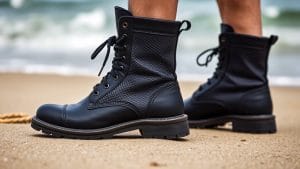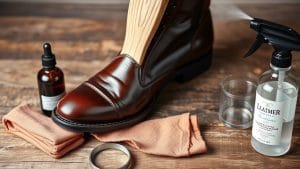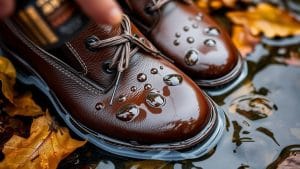This post contains affiliate links. As an Amazon Associate, we earn from qualifying purchases.
To shrink your leather boots, submerge them in lukewarm water for about an hour or use a spray bottle with hot water. After that, wear damp socks inside the boots while they dry together. You can also use a hair dryer on low to help with shrinking. Always finish by applying a leather conditioner to keep the material supple. If you want to explore more effective techniques and tips, keep going!
Key Takeaways
- Submerge leather boots in lukewarm water for about an hour for effective shrinking, or dampen using a spray bottle for targeted areas.
- Wear damp socks inside the wet boots to help mold them to your feet as they dry.
- Use a hair dryer on low speed to apply gentle heat while focusing on loose areas for additional shrinking.
- Always apply a leather conditioner after shrinking to maintain suppleness and prevent drying.
- Consult a professional cobbler if DIY methods do not achieve the desired fit or if the boots are made from delicate materials.
Understanding the Shrinking Process for Leather Boots
When you want to shrink your leather boots, it’s important to understand how the process works. Shrinking typically reduces the size by about a quarter, so it’s a limited solution.
The most common method involves using lukewarm water to shrink your boots. However, excessive soaking can strip the leather of its essential oils, leading to potential damage like chafing or blistering.
Another technique is applying heat with a hair dryer; just keep it at least six inches away to avoid overheating.
After shrinking, always apply a leather conditioner to restore suppleness and prevent cracking.
Essential Tools and Supplies for Shrinking
To effectively shrink your leather boots, you’ll need a few essential tools and supplies.
Gather lukewarm water for dampening the leather and a hair dryer for drying it afterward.
Don’t forget to have leather conditioner on hand to keep your boots looking great after the shrinking process.
Water for Dampening Leather
A key component in shrinking leather boots is water, which plays an essential role in dampening the material.
To effectively shrink your boots, use lukewarm water for soaking. This gentle temperature helps relax the leather fibers without causing damage. Submerge your boots fully in water for about one hour to achieve optimum saturation and maximize shrinkage potential.
If you need to target specific areas, fill a spray bottle with hot water and dampen those parts directly.
Remember, after dampening your leather, always follow up with a leather conditioner to restore moisture and prevent cracking or damage.
Hair Dryer for Drying
Using a hair dryer can be a game-changer in the leather boot shrinking process. By using the hair dryer on low heat, you can carefully dry your damp leather boots after applying moisture, which helps to shrink your leather effectively.
Here are some tips to keep in mind:
- Hold the hair dryer at least 6 inches away to avoid overheating.
- Focus on the loosest areas first for better shrinking.
- Don’t let the heat linger too long to prevent damage to the leather.
- Move the dryer around to guarantee even drying.
- Check if the leather is completely dry after each pass.
Being cautious with heat will help you achieve a snug fit without risking harm to your beloved boots.
Leather Conditioner for Care
While shrinking leather boots can help achieve a better fit, it’s essential to care for the leather afterward to maintain its quality and longevity.
After you’ve shrunk your boots, apply a good leather conditioner once they’re fully dry. This step is vital because shrinking can strip oils from the leather, leading to cracking.
Regularly conditioning every few months keeps the leather hydrated and resilient, especially after exposure to water during the shrinking process.
Be sure to choose a conditioner formulated specifically for leather; not all products are suitable and some may cause damage.
Properly conditioned leather is more resistant to wear and retains its shape, ensuring your boots remain comfortable and stylish for years to come.
Method 1: Using Water to Shrink Boots
If you find your leather boots are a bit too loose, water can be an effective way to shrink them down to size. Here’s how you can do it:
- Fully submerge your leather boots in lukewarm water for about one hour.
- For suede boots, wet the inside only to avoid damage.
- After soaking, wear damp socks inside the wet boots.
- Allow both to dry together, helping the leather mold to your feet.
- Monitor the fit afterward; expect only minimal shrinkage, typically around a quarter size.
Finally, don’t forget to apply leather conditioner post-process to keep your boots supple and prevent damage. This method can help you achieve a better fit for your favorite boots!
Method 2: Shrinking With a Hair Dryer
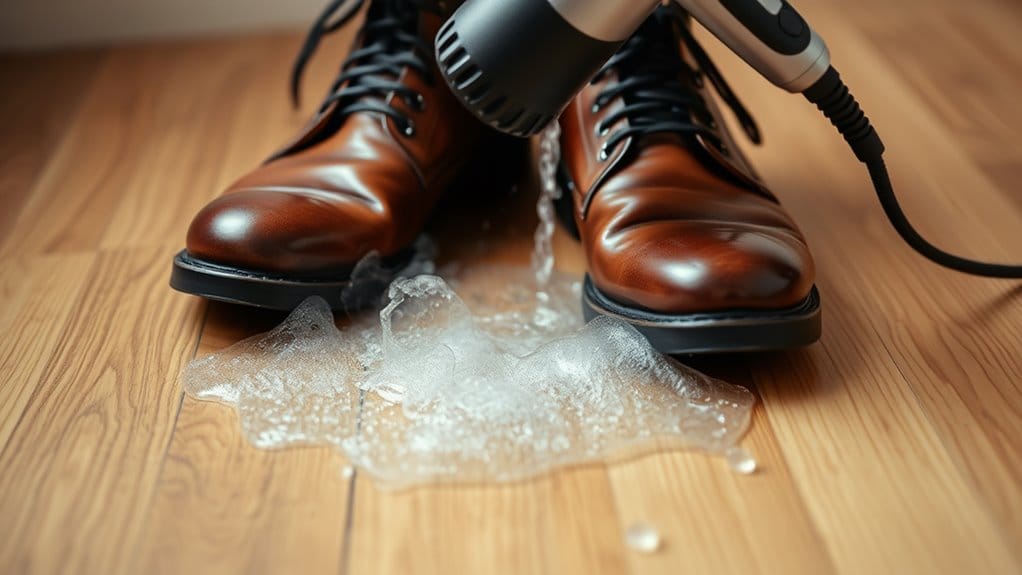
One effective method to shrink leather boots involves a hair dryer, making it a convenient option for a quick fix.
Start by filling a spray bottle with hot water and thoroughly spray the leather surfaces until they’re saturated.
Next, hold the hair dryer on a low speed setting, about 6 inches away, focusing on the loosest parts of the boots first. This helps shrink your boots effectively.
If they still feel too loose after the initial attempt, repeat the spraying and drying process. Always keep an eye on the leather to prevent damage from excessive heat.
Once your boots fit snugly, remember to apply a leather conditioner to maintain their suppleness and avoid cracking.
Post-Shrinking Care for Your Boots
After shrinking your leather boots, it’s essential to make certain they fit comfortably without being too tight.
To guarantee your boots remain in top shape, follow these post-shrinking care tips:
- Allow your boots to dry completely before applying any conditioner.
- Use a high-quality leather conditioner to restore moisture and maintain the leather’s sheen.
- Regularly condition your boots, ideally every few months, to keep the leather supple.
- Store your boots in a cool, dry place to prevent moisture damage.
- Use shoe trees to help maintain their shape and prevent creasing.
These steps won’t only enhance your boots’ appearance but also extend their lifespan, assuring you get the most out of your investment.
Alternative Solutions for Better Fit
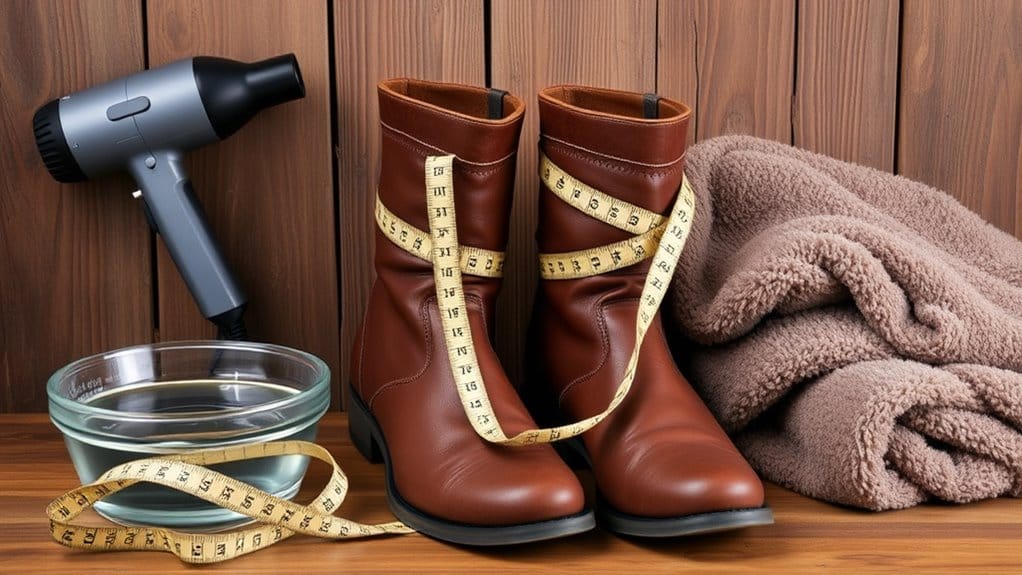
While shrinking your leather boots can help achieve a better fit, there are several alternative solutions that can provide comfort and security without risking damage.
Using insoles or heel pads effectively fills excess volume, creating a snug fit. For a temporary fix, wearing thick socks can make looser boots more comfortable until you find a permanent solution.
Additionally, tongue pads can enhance the fit around the laces, reducing slippage and preventing blisters in slightly oversized boots. If you’re unsure about adjustments, consulting a professional cobbler can give you tailored advice.
Finally, consider kilties, which are decorative pieces placed under the laces to help fill space and secure the fit in wider boots.
Common Misconceptions About Shrinking Leather
When it comes to leather boots, many people confuse shrinking with stretching, leading to misguided attempts at fitting.
You might think that certain methods can effectively shrink your boots, but understanding leather’s unique properties is essential for achieving the best results.
Let’s clear up these misconceptions so you can take better care of your footwear.
Shrinking vs. Stretching Confusion
Many people mistakenly believe that shrinking leather boots is a simple fix for sizing issues, but this misunderstanding can lead to more problems than solutions.
Here’s what you should know:
- Shrinking typically only reduces the size by about a quarter size.
- Soaking boots in water can cause loss of oils and long-term damage.
- Rubber soles prevent effective shrinking, unlike softer materials.
- Heat sources like hair dryers might minimally shrink them but can cause irreversible damage.
- Leather naturally stretches with wear but doesn’t effectively shrink back.
Instead of trying to make them smaller, consider using insoles or pads to help your boots fit your feet better without risking damage.
Misunderstanding Leather Properties
Although you might believe that shrinking leather boots is a straightforward solution, several misconceptions can lead you astray.
For instance, many think soaking leather or using WET socks will effectively shrink leather shoes, but this can strip oils and cause damage. Leather typically only shrinks about a quarter size, and excessive attempts might ruin the material.
Instead of expecting boots to shrink, remember they often stretch with wear, making proper fit essential when purchasing. Additionally, the rubber soles on many boots prevent significant size reduction.
If your boots feel too loose, consider visiting a repair shop for insoles or pads, which can create a better fit without compromising the integrity of your beloved leather footwear.
Tips for Maintaining Leather Quality
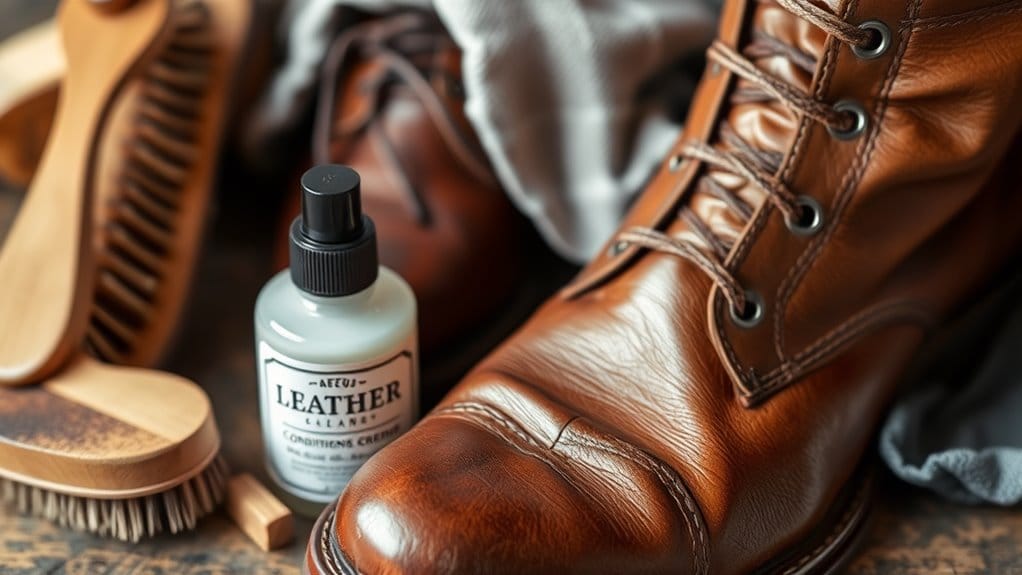
Maintaining leather quality is essential for keeping your boots looking great and lasting longer. Here are some tips to guarantee your leather remains in top shape:
- Regularly apply a high-quality leather conditioner to prevent drying, cracking, or peeling.
- Keep your boots clean by wiping them with a damp cloth to remove dirt and debris.
- Store your boots in a cool, dry place away from direct sunlight to avoid fading.
- Use shoe trees to help retain their shape and prevent warping.
- Protect your boots with sprays specifically designed for leather to enhance water resistance and guard against stains.
When to Seek Professional Help
Even with proper care, there are times when your leather boots might still feel too big or uncomfortable.
If you’ve tried DIY methods but they haven’t worked, it’s wise to consult a professional cobbler. They can make tailored adjustments to guarantee a perfect fit without risking damage to the leather.
This is especially important for high-end or specialty leather boots where maintaining the integrity of the craftsmanship is vital.
If your attempts have caused any deterioration, a cobbler can assess and repair the damage effectively.
For boots made from mixed materials, seeking expert advice can prevent adverse reactions from unsuitable home methods.
When in doubt, getting professional help can save you time and avoid costly mistakes.
Conclusion
To summarize, shrinking your leather boots can be a straightforward process if you follow the right methods and take care of your footwear. Whether you use water, a hair dryer, or explore alternative solutions, always prioritize the leather’s quality. Remember to maintain your boots properly to guarantee longevity. If you’re ever uncertain or if your attempts don’t yield the desired fit, don’t hesitate to seek professional help. Happy boot-wearing!

